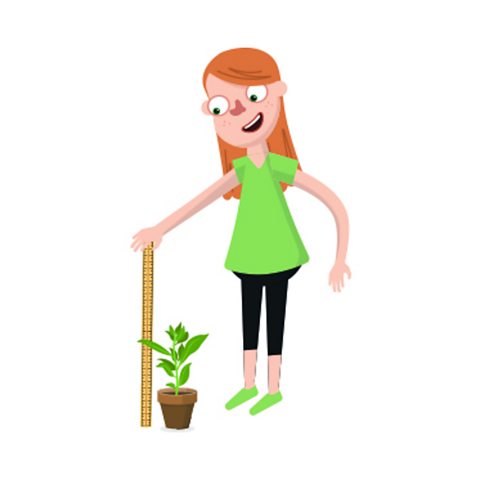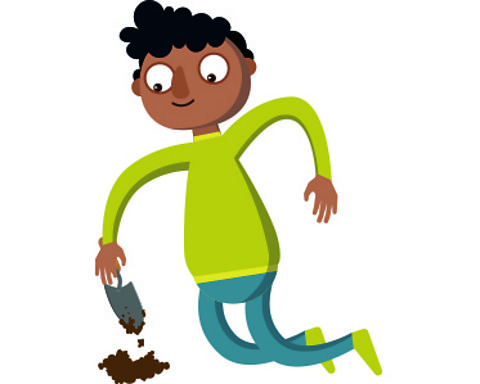
What is photosynthesis?
How do plants obtain the nutrients they need to live and grow? Our catchy photosynthesis rap will explain everything, with a little help from light, water, chlorophyll and carbon dioxide.
The Photosynthesis Rap
Rapper:
Photo is another word for light. Synthesis means make, that's right. To make this happen we need four things, can you tell me what they are? Wanna hear you sing. Light; water; CO2; chlorophyll. Light; water; CO2; chlorophyll. Light; water; CO2; chlorophyll. Light; water; CO2; chlorophyll. Light comes from the sun. giving energy, that's how it's done. Water is the oxygen holder. H2Oyeah, just told yer. CO2, well that comes from you. Chlorophyll, chlorophyll, chlorophyll. Well, the green chemical inside the chloroplast of plant cells. It enables photosynthesis to take place. Stage one, first you're gonna need some light. Make sure you got specific enzymes. Chlorophyll is now what you need. It takes the light to make energy. Water is now split by the energywhich came from the light. Are you following me? This produces hydrogen we need for stage two. And oxygen is released for you.
Rapper:
Stage two, is carbon fixation. It happens in plants all over the nation. The hydrogen in stage one mixes with CO2, oh such fun. What do we get from this? Sugar, that's how the plants live. I'm going to let my homeboy sing you out with the four things that we need for photosynthesis. Can we remember what they are? Now repeat after me. Light. Water. CO2. Chlorophyll. Light;water; CO2; chlorophyll. Light; water; CO2; chlorophyll. Light; water; CO2; chlorophyll. Light; water; CO2; chlorophyll. Light; water; CO2; chlorophyll. Light; water; CO2; chlorophyll. Light; water; CO2; chlorophyll. Light; water; CO2; chlorophyll.
How to be a terrific plant detective
Do you know your dandelions from your daisies? Click on the picture below and see if you have what it takes to be a plant detective. How many of them can you find?
When flowers fight back: How plants defend themselves
Plants of course cannot move away from danger, but that wonÔÇÖt stop them from putting up a fight if they are threatened. Click on the picture of the killer plant and find out the many amazing ways that plants have of keeping you away!
Corpse flowers and flinching leaves: Six amazing plants!
Take a look at some of the strangest, scariest and most wonderful plants on the planet, and find out what makes them so special.
Quick-acting carnivore!
Have you ever heard of a meat-eating plant? There are a number of different plants around the world that catch and digest animals. One of the most amazing is the Venus flytrap, found in parts of North and South Carolina in the USA. These alien-looking plants catch insects within their leaves and digest their bodies.
Their leaf traps work due to a series of small hairs on their surface that sense movement. If more than two of these hairs are touched one after the other, the plant snaps its leaf shut in half a second. The plant then releases chemicals to slowly digest the insect over about ten days. After this time, the leaf reopens.
ItÔÇÖs worth noting that the Venus flytrap doesnÔÇÖt get its energy from eating meat. It photosynthesises like most other plants. Instead, the plant uses insects to make up for the lack of nutrients it gets from the poor soil of boggy grasslands
The Venus flytrap appears to have a mouth for eating meat, but what's really going on?
Narrator:
This is a highly sophisticated trap. The bait, sugary nectar around the rim of the disc. The triggers, fine hairs, two of which have to be touched within 20 seconds of each other. The victim, a fly which finds the colour and nectar irresistible One two When triggered, the trap snaps shut so fast that the fly is imprisoned The Venus Fly Trap now slowly digests its victim.
Growth champion
Not just the favourite food of pandas, bamboos are the fastest growing plants on the planet.
One species has been found to grow up to 91 cm per day!To give you an idea of how this compares, an average four-year-old child grows about 6.5cm a year.
Bamboo species are the fastest growing plants on the planet.

The corpse flower
The biggest flower of any plant on Earth is found on the Rafflesia arnoldii plant in the rainforests of Sumatra and Borneo, although it looks like something out of a science fiction film set on another planet!
This rare bloom can grow to around a metre wide and has no leaves, roots or stem, as it is able to survive by stealing its nutrients and water from other plants. ItÔÇÖs no sweet smelling rose either - it is known for having a horrible smell of decaying meat, which has led to it being nicknamed 'corpse flower'! ItÔÇÖs this stink that attracts insects to pollinate the flower.
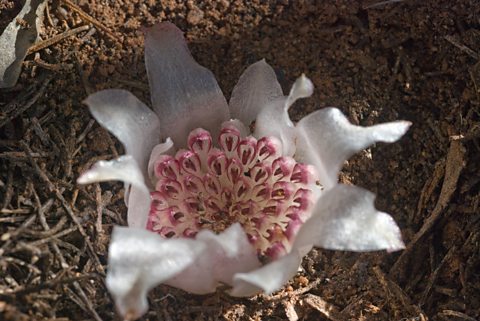
Sunless flowers
The western underground orchid is one of very few plants in the world that bloom underground. The plant spends its entire life underground and its cream and pink flower matures and blossoms a few centimetres beneath the soil, reaching heights of, at most, just two centimetres above the ground.
Unlike the majority of plants, it doesnÔÇÖt draw energy from sunlight. Instead, it takes its nutrients from fungi and bushes growing nearby. It doesnÔÇÖt contain chlorophyll, the green substance that allows for photosynthesis, so the plant has no green colour at all.
The orchid is extremely rare and is thought to only grow in parts of Western Australia.
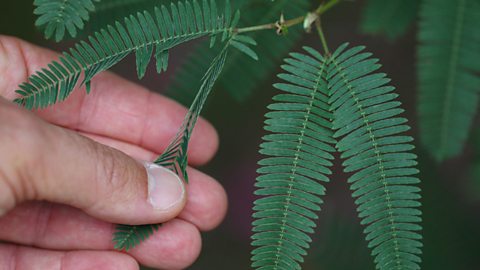
Plants have feelings too?
Do plants have feelings? ItÔÇÖs unlikely, as they donÔÇÖt have central nervous systems, but youÔÇÖd be forgiven for thinking so if youÔÇÖve ever come across the Mimosa pudica, or sensitive plant.
These plants have leaves which spring back upon being touched, as a result of water being withdrawn from them. This is thought to be a defence mechanism against herbivores: bigger animals might be startled by the movement while insects may be shaken off the plant.
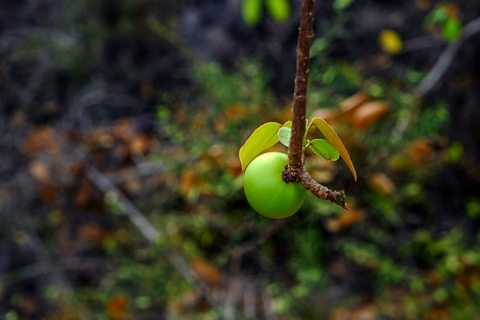
Leafy and lethal
There are lots of plants out there that can cause us harm, either through being poisonous to eat or toxic to the touch. One of the most dangerous is the manchineel, found in the northern parts of South America, parts of Central America and the very south of the USA.
The tree produces a milky sap that is dangerous to the touch, even just brushing past it may leave you with badly burnt skin and blisters, as if youÔÇÖd poured boiling water over yourself. People shouldnÔÇÖt try and take shelter from the rain beneath one either, as even watered down the sap can give a nasty rash. And if the tree is burnt, the smoke produced can temporarily blind and cause breathing problems.
Worst of all, the fruit of the manchineel, which looks like a small green apple, can cause fatal dehydration from the awful sickness and stomach upsets it causes if eaten!
Four ways plants could help our future
Plants are pretty amazing. They provide us with food, medicines, and materials to build with. And weÔÇÖre still discovering new species, new uses for plants we know about and new ways of growing plants. With the worldÔÇÖs population getting bigger, here are some of the ways scientists are looking at the power of plants to provide for people in future.

Plants in space
NASA and other space agencies are looking at how humans might one day travel to Mars and even set up a space to live there. However, thereÔÇÖs no chance of taking enough food to last very long, so if humans are going to live on Mars for any length of time, theyÔÇÖre going to need to grow their own vegetables. But growing plants on other planets is not easy. For a start, the pull of gravity is different. Light and temperature levels will also be very different, as will the make-up of the soil and the gases in the atmosphere.
For a number of years, astronauts on the International Space Station have been experimenting with different ways to grow plants in space. In 2015, astronauts on board ate food grown on board the ISS for the first time, tucking in to some red romaine lettuce grown in a system called VEGGIE. This system grows plants on ÔÇÿpillowsÔÇÖ of clay, fertiliser and water, while light is provided by a system of LEDs. On Earth meanwhile, scientists have been growing plants in soils that are similar in make-up to those on Mars. So far, plants successfully grown in these soils include wheat and tomatoes.
ThereÔÇÖs lots of work to be done still, but one day humans might be tucking in to a full veggie dinner grown on the red planet!
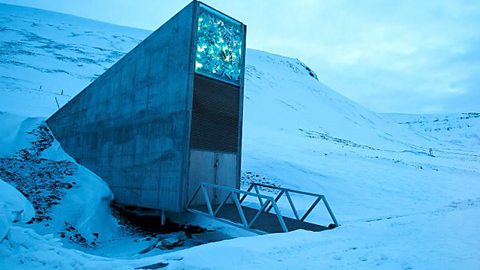
Storing seeds
Around half of the worldÔÇÖs calorie intake is provided by just three plants: rice, maize and wheat. If one of these suddenly died out, we would have a huge problem on our hands. This is unlikely to happen to these any time soon, but with one in five plants at risk of extinction, itÔÇÖs important to make sure we donÔÇÖt lose any plants that might be useful.
For this reason, scientists in different parts of the world have set up seed banks. Seed banks are libraries that store seeds so that they can be replanted in case of disaster and accessed by scientists to study. TheyÔÇÖre a way of making sure that plants that are useful, or could be useful in future, are not lost due to natural disasters, climate change, diseases or the destruction of their habitats.
One of the most famous seed banks is NorwayÔÇÖs Svalbard Global Seed Vault, which is built into the side of an arctic mountain and designed to withstand natural disasters. The bank is a ÔÇÿback upÔÇÖ of many of the worldÔÇÖs plants so we have an emergency supply to replant them. Seeds in the bank are not to be accessed unless there is an emergency. In fact, security is so tight, no one person has access to all of the codes needed to access the seeds. Seeds are frozen to keep them for many years, and its location means that even if the power failed, its cold enough for them to stay frozen for a long time.
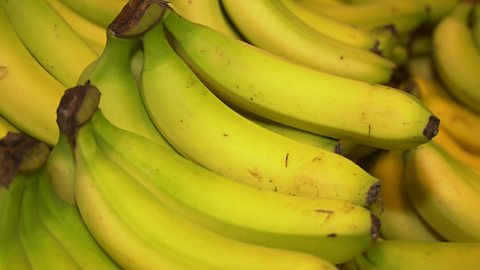
Tough plants
There are lots of different varieties of each type of fruit, vegetable and cereal. But over time farmers have learnt which of these varieties are popular, easy to grow and make them a profit, so they concentrate on growing those varieties in their farms. This means that some varieties of crops have become so common that hardly any other variety of that crop is grown on any farm. As lots of farms are growing very similar plants it means whole harvests of each crop are vulnerable to the same threats - one small change to the climate, or the spread of a disease or pest, could mean the whole harvest is at risk.
Some of the most important plants being studied by scientists are wild relatives of the vegetables and cereals we eat. This is because they may have features that would be useful for the food plants to have too, which would protect them from these threats. For example, the ÔÇÿwildÔÇÖ relatives might be resistant to certain diseases, need less water or the able to grow in different soils. Scientists are working to make new varieties of common food plants by breeding them with these similar plants. That way, future generations of food crops might also have some of these features.
Scientists are also looking at how easily different plants catch fire, to try and cut down on the destruction caused by wildfires. Scientists hope that this knowledge can help to plan landscapes that stop fires spreading. The more flame-resistant plants that can be planted in among forests, the more likely that fire will not spread so far, so scientists need to know which plants could be introduced to forests in danger of fire as defenders of those around them.
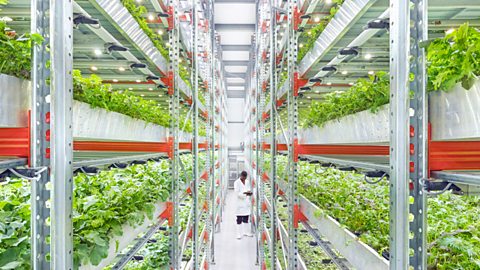
Going up?
In many places across the world, more and more people are living in cities, further away from farms growing vegetables and crops. This means that lots more food has to travel a long way to get from farms to forks, which isnÔÇÖt good for the environment and can lead to food being wasted.
A solution to this is to grow food in the cities where lots of people will be eating it. One method for this is vertical farming, where plants are grown in towers rather than across fields, so less land is needed. This means food can be grown in city spaces, where there is less available land space.
Vertical farms look less like farms and more like warehouses, with plants grown on shelves one above another. Technology can be used to help the plants photosynthesise and grow. Often daylight is recreated using a system of LEDs that can trick plants into thinking it is summer all year round. The temperature and watering can both be controlled by sensors, and plants are often grown in water full of nutrients instead of soil. Lettuces, tomatoes and other leafy green vegetables can all be grown this way.

